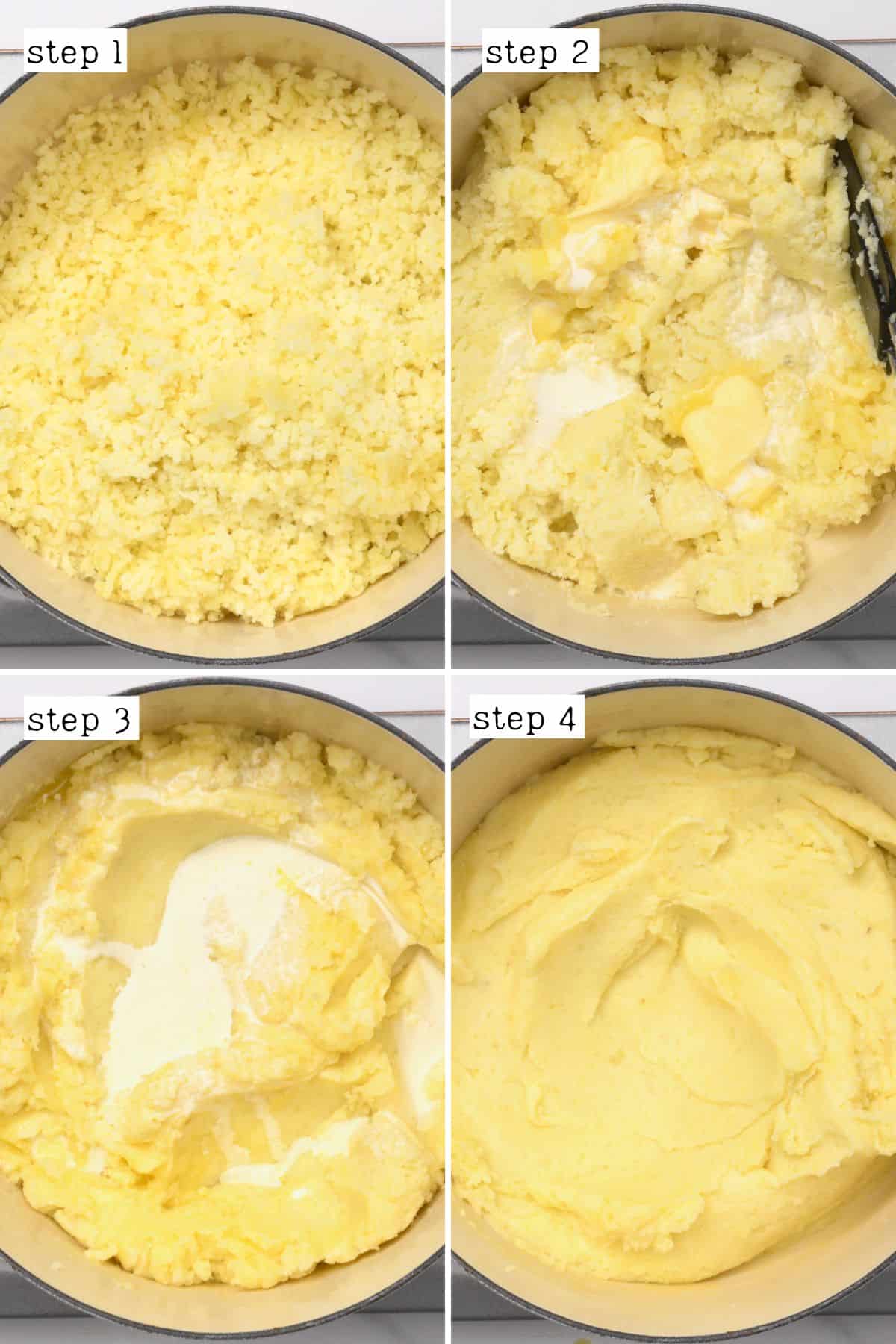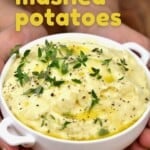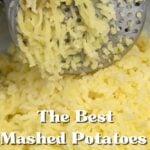This post may contain affiliate links. Please read our disclosure policy.
How to make the BEST creamy mashed potatoes with a few top tips for the ultimate side dish to any meal! They’re velvety, fluffy, rich, and make-ahead friendly!

Is there any meal that a heaped serving of mashed potatoes (regular, sweet potatoes, or purple potatoes) can’t substantially enhance? If I have anything to say about it, then the answer is no. Which is why it’s the perfect time to learn how to make creamy mashed potatoes!
With just 4 ingredients and a few key tips, get ready to make the BEST mashed potatoes for mid-week meals, special occasions, a roast dinner, and the Holidays (like Thanksgiving and Christmas). They’re drool-worthy with a creamy, rich, fluffy, velvety texture and buttery taste. You could say the ultimate comfort food?!
Best of all, not only is making mashed potatoes creamy simple, but this mash can be made ahead of time, freezes and reheats well, and you can adapt it in numerous ways for different flavor and dietary preferences (like vegan mashed potatoes). You’ll never have to worry about gummy, dense, lumpy mash again.

Want to save this recipe?
Ingredients for Mashed Potatoes
- Potatoes: Use Russet potatoes (starchy) or Yukon Gold (all-purpose, slightly waxier for a buttery consistency) for the best potato mash.
- Water + salt: To use when boiling the potatoes.
- Butter: It’s best to use (dairy or dairy-free) unsalted butter, though salted will work in a pinch. Olive oil also works but imparts more flavor to the potatoes.
- Cream: For the creamiest mashed potatoes, use heavy cream (double cream) or dairy-free full-fat canned coconut milk. Milk will work for a lighter mash – or a combination of both.
Refer to the Recipe Card Notes section for plenty of ways to boost the flavor (and texture) of your homemade mashed potatoes.

How to Make Creamy Mashed Potatoes
Follow just three simple “stages” to prepare this simple creamy mashed potatoes recipe.
Step 1: Boil the potatoes
First, wash the potatoes (use a vegetable brush if needed) and then either leave them whole – as I do – or optionally peel and chop them into 1-inch pieces.
If you have the time, I highly recommend boiling them whole, as chopped potatoes can lead to more watery mash. If you do peel them, save the peels for potato peel chips.
Then, add the potatoes to a large pot and cover them with 1-2 inches of cold water. Add the salt and then bring the potatoes to a boil.

Lower the heat to a simmer (medium-low), and cook the potatoes until knife or fork tender. For whole potatoes, that’s about 40-45 minutes, for cubed potatoes, it’s about 15-20 minutes.
For more tips, check out my post on how to boil potatoes (whole or cubed). Alternatively, you could steam or bake the potatoes until tender.
Step 2: Mash the potatoes
Thoroughly drain the water and allow the potatoes to cool until you’re able to handle them before removing the peel. It should slip off easily (you can skip this step, though, if using a potato ricer to mash).
Use a kitchen towel to hold the potatoes, if needed. If using chopped potatoes, add them back to the pan so the residual heat can steam out any excess water while you mash.
Then, either in the saucepan or in a large dish with plenty of flat surface area, use a potato masher, food mill/potato ricer (for super fluffy and smooth mash), or a sturdy fork (for thicker, chunkier mash) to mash the potatoes to your desired consistency.

While it’s possible to use a mixer over low speed, there’s a higher chance of the potatoes becoming gummy.
Step 3: Season and serve
Slowly incorporate the butter and cream into the mashed potatoes, first the butter, then the cream. Stir between every addition until it’s reached your desired consistency.
Also, taste and add more salt if preferred before finally serving the creamy mashed potatoes mixture in a large bowl with an optional drizzle of melted butter or olive oil, black pepper, and a sprinkle of parsley, chives, green onions, or rosemary. Enjoy!

To peel or not to peel potatoes for mashed potatoes
Essentially, this comes down to personal preference, but I prefer not to peel the potatoes, at least before boiling them.
By leaving the potatoes whole and unpeeled, not only will they retain more nutrients and flavor while they boil, but they won’t soak up excess water either (which can make it harder for the potatoes to absorb the butter/cream AND turn the mash watery).
They’re also really easy to peel after boiling, though the actual boiling process takes quite a bit longer than for 1-inch cubes.
You can also leave the potato peel in the mashed potato entirely for extra fiber, nutrients, and a more rustic mash.
Top Tips for the best creamy mashed potatoes
- Choose the right potatoes: It’s best to use starchy potatoes vs. waxy ones, which can become overly thick and dense when mashed. I recommend Russet potatoes or Yukon Gold potatoes.
- Boil the potatoes whole: If you have the time, boiling whole potatoes retains more nutrients and flavor and stops the potatoes from becoming watery.
- Don’t overcook potatoes: Especially when boiling chopped, as they become watery.
- Fully drain the liquid: So you don’t accidentally end up with a watery mash.
- Mash while warm: They’re easier to mash, and the cream/butter incorporates better.
- Use warm liquids: Not only do they incorporate better, but they’ll help keep the mashed potatoes warmer for longer. It’s also best to add the butter first.
- For the fluffiest mash: Use a potato ricer over other methods to mash the potatoes.
- Adjust the consistency: i.e., using just butter makes a thick, scoopable mash. Adding a little liquid makes it creamier, adding even more liquid makes a lighter, more velvety mash. For that reason, it’s important to add the cream/butter incrementally.
- Don’t overwork the potatoes: Otherwise, you can accidentally activate the starches and turn the potatoes gummy and dense.
What to eat with mashed potatoes?
Creamy mashed potatoes make for the ultimate side dish to practically any meal, especially on your Holiday table. Enjoy it alongside:
- Meatballs or meatloaf,
- Bolognese or mushroom ragu,
- Sausages (to make “bangers and mash”),
- Baked salmon,
- Air fryer steak, slow cooker beef brisket, or baked short ribs,
- Whole roasted chicken (or turkey) or fried chicken,
- Stews and casseroles,
- Pies and tarts (including over a Shepherd’s pie, Cottage pie),
- Other holiday sides – like green beans, candied yams, stuffing, and gravy.
You can use leftover mashed potatoes to make potato cakes, dumplings, or gnocchi.
Planning on feeding a crowd? Keep the mashed potatoes in a crockpot on the low/warm setting until it’s time to serve!

Make ahead mashed potatoes
Store: You can prepare the entirety of the mashed potatoes (cooked, mashed, and seasoned) 2-3 days in advance. Store it tightly wrapped/in an airtight container in the refrigerator, and reheat it as needed.
Reheat: It’s best to reheat mashed potatoes either in a microwave or on the stove, adding extra milk/cream if needed to achieve your desired consistency – as they can dry out a little.
Can you freeze mashed potatoes?
I’ve found these creamy mash freezes very well in several ways. First, allow it to cool. Then, either portion it to store in airtight, freezer-safe containers or bags (spread flat with excess air squeezed out) OR add scoops to a parchment-lined tray to flash freeze until solid, then transfer to a contain/bag.
For the best results, freeze the mash for up to 2 months, though it will last a little longer than that. You can then leave it to thaw overnight in the refrigerator or reheat it from frozen in the oven at 350ºF/175ºC until heated through (about 30 minutes).
More Holiday side dishes
If you try this creamy mashed potatoes recipe, let me know how it goes in the comments below. I’d appreciate a recipe card rating and would love to see your recipe recreations – tag me on Instagram @Alphafoodie!

Creamy Mashed Potatoes
Equipment
- Potato ricer or potato masher
Ingredients
- 2.4 lb potatoes 5 large ones; russet, Yukon gold, or Maris Piper in UK
- 2 tsp salt
- 4.5 oz butter 1/2 cup; unsalted; dairy or dairy-free
- 4.3 oz heavy cream (double cream) 1/2 cup OR dairy-free canned coconut milk; for a lighter version, use milk.
Instructions
Boil the potatoes
- Wash the potatoes (use a vegetable brush if needed) and then either leave them whole – as I do- or optionally peel and chop them into 1-inch pieces.If you have the time, I highly recommend boiling them whole and unpeeled, as chopped potato can lead to more watery mash.
- Add the potatoes to a large saucepan and cover them with 1-2 inches of cold water. Add the salt and then bring the potatoes to a boil.
- Lower the heat to a simmer (medium-low), and cook the potatoes until knife or fork tender. For whole potatoes, that's about 40-45 minutes, for cubed potatoes it's about 15-20 minutes.
Mash the potatoes
- Thoroughly drain the water and allow the potatoes to cool until you're able to handle them before removing the peel. It should slip off easily (you can skip this step, though, if using a potato ricer to mash).Use a kitchen towel to hold the potatoes, if needed. If you’re using chopped potatoes, add them back to the pan so the residual heat can steam out any excess water while you mash.
- Either in the saucepan or in a large dish with plenty of flat surface area, use a potato masher, food mill/potato ricer (for super fluffy and smooth mash), or a sturdy fork (for thicker, chunkier mash) to mash the potatoes to your desired consistency.While it's possible to use a mixer over low speed, there's a higher chance of the potatoes becoming gummy.
Season and serve
- Slowly incorporate the butter and cream into the mashed potatoes, first the butter then cream, stirring between every addition until it's reached your desired flavor and consistency.
- Also, taste and add more salt if preferred before finally serving the creamy mashed potatoes with an optional drizzle of melted butter or olive oil and sprinkle of parsley, chives, green onions, or rosemary. Enjoy!
Notes
- Bay leaf: Add to the potatoes while they boil for more savory depth.
- Sour cream: Replace some cream with sour cream for added tang.
- Garlic: Make delicious garlic mashed potatoes using about 1 clove per lb. of potatoes OR more roasted garlic, or some garlic powder – added to taste.
- Fresh herbs: Chives, scallions, parsley, etc. Stir in or use to garnish.
- Herb-infused cream: Add the herbs (rosemary, sage, or thyme) to a saucepan with the cream (or milk) and simmer for 5 minutes. Then leave to infuse, off-heat, for 20-30 minutes while the potatoes cook.
- Cheesy mashed potatoes: Add creamy, cheesy flavor with your favorite cream cheese (dairy or dairy-free, plain or flavored like Boursin) and/or about ½ cup of shredded cheese like a sharp cheddar or parmesan.
- Fully loaded mashed potatoes: Add cheddar, green onions, and crispy bacon.
- Smoked paprika: For a subtle smoky flavor.
- Truffle oil: Make a decadent truffle mash by replacing 1 Tbsp butter with the oil.
- Veggies: Broccoli, peas, corn, or spinach for nutrients, color, and texture.
Nutrition
Nutrition information is automatically calculated, so should only be used as an approximation.

















